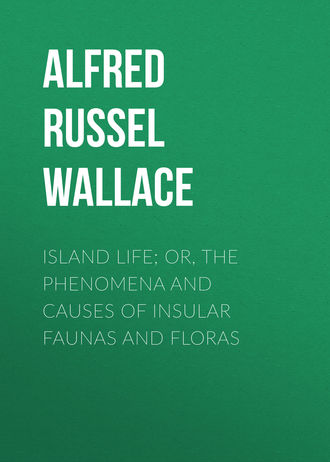 полная версия
полная версияIsland Life; Or, The Phenomena and Causes of Insular Faunas and Floras
The following analysis of chalk by Mr. D. Forbes will show the difference between the two formations:—

(From Quarterly Journal of the Geological Society, Vol. XXVII.)
The large proportion of carbonate of lime, and the very small quantity of silica, alumina, and insoluble débris, at once distinguish true chalk from the Globigerina-ooze of the deep ocean bed.
24
Notes on Reticularian Rhizopoda; in Microscopical Journal, Vol. XIX., New Series, p. 84.
25
Proceedings of the Royal Society, Vol. XXIV. p. 532.
26
See Presidential Address in Sect. D. of British Association at Plymouth, 1877.
27
Geological Magazine, 1871, p. 426.
28
In his lecture on Geographical Evolution (which was published after the greater part of this chapter had been written) Sir Archibald Geikie expresses views in complete accordance with those here advocated. He says:—"The next long era, the Cretaceous, was more remarkable for slow accumulation of rock under the sea than for the formation of new land. During that time the Atlantic sent its waters across the whole of Europe and into Asia. But they were probably nowhere more than a few hundred feet deep over the site of our continent, even at their deepest part. Upon their bottom there gathered a vast mass of calcareous mud, composed in great part of foraminifera, corals, echinoderms, and molluscs. Our English chalk, which ranges across the north of France, Belgium, Denmark, and the north of Germany, represents a portion of the deposits of that sea-floor." The weighty authority of the Director-General of the Geological Survey may perhaps cause some geologists to modify their views as to the deep-sea origin of chalk, who would have treated any arguments advanced by myself as not worthy of consideration.
29
Introduction and Succession of Vertebrate Life in America, by Professor O. C. Marsh. Reprinted from the Popular Science Monthly, March, April, 1878.
30
Physical Geography and Geology of Great Britain, 5th Ed. p. 61.
31
Of late it has been the custom to quote the so-called "ridge" down the centre of the Atlantic as indicating an extensive ancient land. Even Professor Judd at one time adopted this view, speaking of the great belt of Tertiary volcanoes "which extended through Greenland, Iceland, the Faroe Islands, the Hebrides, Ireland, Central France, the Iberian Peninsula, the Azores, Madeira, Canaries, Cape de Verde Islands, Ascension, St. Helena, and Tristan d'Acunha, and which constituted as shown by the recent soundings of H.M.S. Challenger a mountain-range, comparable in its extent, elevation, and volcanic character with the Andes of South America" (Geological Mag. 1874, p. 71). On examining the diagram of the Atlantic Ocean in the Challenger Reports, No. 7, a considerable part of this ridge is found to be more than 1,900 fathoms deep, while the portion called the "Connecting Ridge" seems to be due in part to the deposits carried out by the River Amazon. In the neighbourhood of the Azores, St. Paul's Rocks, Ascension, and Tristan d'Acunha are considerable areas varying from 1,200 to 1,500 fathoms deep, while the rest of the ridge is usually 1,800 or 1,900 fathoms. The shallower water is no doubt due to volcanic upheaval and the accumulation of volcanic ejections, and there may be many other deeply submerged old volcanoes on the ridge; but that it ever formed a chain of mountains "comparable in elevation with the Andes," there seems not a particle of evidence to prove. It is however probable that this ridge indicates the former existence of some considerable Atlantic islands, which may serve to explain the presence of a few identical genera, and even species of plants and insects in Africa and South America, while the main body of the fauna and flora of these two continents remains radically distinct.
In my Darwinism (pp. 344-5) I have given an additional argument founded on the comparative height and area of land with the depth and area of ocean, which seems to me to add considerably to the weight of the evidence here submitted for the permanence of oceanic and continental areas.
32
In a review of Mr. T. Mellard Reade's Chemical Denudation and Geological Time, in Nature (Oct. 2nd, 1879), the writer remarks as follows:—"One of the funny notions of some scientific thinkers meets with no favour from Mr. Reade, whose geological knowledge is practical as well as theoretical. They consider that because the older rocks contain nothing like the present red clays, &c., of the ocean floor, that the oceans have always been in their present positions. Mr. Reade points out that the first proposition is not yet proved, and the distribution of animals and plants and the fact that the bulk of the strata on land are of marine origin are opposed to the hypothesis." We must leave it to our readers to decide whether the "notion" developed in this chapter is "funny," or whether such hasty and superficial arguments as those here quoted from a "practical geologist" have any value as against the different classes of facts, all pointing to an opposite conclusion, which have now been briefly laid before them, supported as they are by the expressed opinion of so weighty an authority as Sir Archibald Geikie, who, in the lecture already quoted says:—"From all this evidence we may legitimately conclude that the present land of the globe, though formed in great measure of marine formations, has never lain under the deep sea; but that its site must always have been near land. Even its thick marine limestones are the deposits of comparatively shallow water."
33
Antiquity of Man, 4th Ed. pp. 340-348.
34
The Great Ice Age and its Relation to the Antiquity of Man. By James Geikie, F.R.S. (Isbister and Co., 1874.)
35
This view of the formation of "till" is that adopted, by Dr. Geikie, and upheld by almost all the Scotch, Swiss, and Scandinavian geologists. The objection however is made by many eminent English geologists, including the late Mr. Searles V. Wood, Jun., that mud ground off the rocks cannot remain beneath the ice, forming sheets of great thickness, because the glacier cannot at the same time grind down solid rock and yet pass over the surface of soft mud and loose stones. But this difficulty will disappear if we consider the numerous fluctuations in the glacier with increasing size, and the additions it must have been constantly receiving as the ice from one valley after another joined together, and at last produced an ice-sheet covering the whole country. The grinding power is the motion and pressure of the ice, and the pressure will depend on its thickness. Now the points of maximum thickness must have often changed their positions, and the result would be that the matter ground out in one place would be forced into another place where the pressure was less. If there were no lateral escape for the mud, it would necessarily support the ice over it just as a water-bed supports the person lying on it; and when there was little drainage water, and the ice extended, say, twenty miles in every direction from a given part of a valley where the ice was of less than the average thickness, the mud would necessarily accumulate at this part simply because there was no escape for it. Whenever the pressure all round any area was greater than the pressure on that area, the débris of the surrounding parts would be forced into it, and would even raise up the ice to give it room. This is a necessary result of hydrostatic pressure. During this process the superfluous water would no doubt escape through fissures or pores of the ice, and would leave the mud and stones in that excessively compressed and tenacious condition in which the "till" is found. The unequal thickness and pressure of the ice above referred to would be a necessary consequence of the inequalities in the valleys, now narrowing into gorges, now opening out into wide plains, and again narrowed lower down; and it is just in these openings in the valleys that the "till" is said to be found, and also in the lowlands where an ice-sheet must have extended for many miles in every direction. In these lowland valleys the "till" is both thickest and most wide-spread, and this is what we might expect. At first, when the glaciers from the mountains pushed out into these valleys, they would grind out the surface beneath them into hollows, and the drainage-water would carry away the débris. But when they spread all over the surface from sea to sea, and there was little or no drainage water compared to the enormous area covered with ice, the great bulk of the débris must have gathered under the ice wherever the pressure was least, and the ice would necessarily rise as it accumulated. Some of the mud would no doubt be forced out along lines of least resistance to the sea, but the friction of the stone-charged "till" would be so enormous that it would be impossible for any large part of it to be disposed of in this way.
36
That the ice-sheet was continuous from Scotland to Ireland is proved by the glacial phenomena in the Isle of Man, where "till" similar to that in Scotland abounds, and rocks are found in it which must have come from Cumberland and Scotland, as well as from the north of Ireland. This would show that glaciers from each of these districts reached the Isle of Man, where they met and flowed southwards down the Irish Sea. Ice-marks are traced over the tops of the mountains which are nearly 2,000 feet high. (See A Sketch of the Geology of the Isle of Man, by John Horne, F.G.S. Trans. of the Edin. Geol. Soc. Vol. II. pt. 3, 1874.)
37
The Great Ice Age, p. 177.
38
These are named, in descending order, Hessle Boulder Clay, Purple Boulder Clay, Chalky Boulder Clay, and Lower Boulder Clay—below which is the Norwich Crag.
39
"On the Climate of the Post-Glacial Period." Geological Magazine, 1872, pp. 158, 160.
40
Geological Magazine, 1876, p. 396.
41
Early Man in Britain and his Place in the Tertiary Period, p. 113.
42
Heer's Primæval World of Switzerland Vol. II., pp. 148-168.
43
Dr. James Geikie in Geological Magazine, 1878, p. 77.
44
This subject is admirably discussed in Professor Asa Gray's Lecture on "Forest Geography and Archæology" in the American Journal of Science and Arts, Vol. XVI. 1878.
45
In a letter to Nature of October 30th, 1879, the Rev. O. Fisher calls attention to a result arrived at by Pouillet, that the temperature which the surface of the ground would assume if the sun were extinguished would be -128° F. instead of -239° F. If this corrected amount were used in our calculations, the January temperature of England during the glacial epoch would come out 17° F., and this Mr. Fisher thinks not low enough to cause any extreme difference from the present climate. In this opinion, however, I cannot agree with him. On the contrary, it would, I think, be a relief to the theory were the amounts of decrease of temperature in winter and increase in summer rendered more moderate, since according to the usual calculation (which I have adopted) the differences are unnecessarily great. I cannot therefore think that this modification of the temperatures, should it be ultimately proved to be correct (which is altogether denied by Dr. Croll), would be any serious objection to the adoption of Dr. Croll's theory of the Astronomical and Physical causes of the Glacial Epoch.
The reason of the theoretical increase of summer heat being greater than the decrease of winter cold is because we are now nearest the sun in winter and farthest in summer, whereas we calculate the temperatures of the glacial epoch for the phase of precession when the aphelion was in winter. A large part of the increase of temperature would no doubt be used up in melting ice and evaporating water, so that there would be a much less increase of sensible heat; while only a portion of the theoretical lowering of temperature in winter would be actually produced owing to equalising effect of winds and currents, and the storing up of heat by the earth and ocean.
46
Dr. Croll says this "is one of the most widespread and fundamental errors within the whole range of geological climatology." The temperature of the snow itself is, he says, one of the main factors. (Climate and Cosmology, p. 85.) But surely the temperature of the snow must depend on the temperature of the air through which it falls.
47
In an account of Prof. Nordenskjöld's recent expedition round the northern coast of Asia, given in Nature, November 20th, 1879, we have the following passage, fully supporting the statement in the text. "Along the whole coast, from the White Sea to Behring's Straits, no glacier was seen. During autumn the Siberian coast is nearly free of ice and snow. There are no mountains covered all the year round with snow, although some of them rise to a height of more than 2,000 feet." It must be remembered that the north coast of Eastern Siberia is in the area of supposed greatest winter cold on the globe.
48
Dr. Croll objects to this argument on the ground that Greenland and the Antarctic continent are probably lowlands or groups of islands. (Climate and Cosmology, Chap. V.)
49
"On the Glacial Epoch," by James Croll. Geol. Mag. July, August, 1874.
50
"The general absence of recent marks of glacial action in Eastern Europe is well known; and the series of changes which have been so well traced and described by Prof. Szabó as occurring in those districts seems to leave no room for those periodical extensions of 'ice-caps' with which some authors in this country have amused themselves and their readers. Mr. Campbell, whose ability to recognise the physical evidence of glaciers will scarcely be questioned, finds quite the same absence of the proof of extensive ice-action in North America, westward of the meridian of Chicago." (Prof. J. W. Judd in Geol. Mag. 1876, p. 535.)
The same author notes the diminution of marks of ice-action on going eastward in the Alps; and the Altai Mountains far in Central Asia show no signs of having been largely glaciated. West of the Rocky Mountains, however, in the Sierra Nevada and the coast ranges further north, signs of extensive old glaciers again appear; all which phenomena are strikingly in accordance with the theory here advocated, of the absolute dependence of glaciation on abundant rainfall and elevated snow-condensers and accumulators.
51
I have somewhat modified this whole passage in the endeavour to represent more accurately the difference between the views of Dr. Croll and Sir Charles Lyell.
52
For numerous details and illustrations see the paper—"On Ocean Currents in Relation to the Physical Theory of Secular Changes of Climate"—in the Philosophical Magazine, 1870.
53
See Darwin's Naturalist's Voyage Round the World, 2nd Edition, pp. 244-251.
54
The influence of geographical changes on climate is now held by many geologists who oppose what they consider the extravagant hypotheses of Dr. Croll. Thus, Prof. Dana imputes the glacial epoch chiefly, if not wholly, to elevation of the land caused by the lateral pressure due to shrinking of the earth's crust that has caused all other elevations and depressions. He says: "Now, that elevation of the land over the higher latitudes which brought on the glacial era is a natural result of the same agency, and a natural, and almost necessary, counterpart of the coral-island subsidence which must have been then in progress. The accumulating, folding, solidification, and crystallisation of rocks attending all the rock-making and mountain-making through the Palæozoic, Mesozoic, and Cenozoic eras, had greatly stiffened the crust in these parts; and hence in after times, the continental movements resulting from the lateral pressure necessarily appeared over the more northern portions of the continent, where the accumulations and other changes had been relatively small. To the subsidence which followed the elevation the weight of the ice-cap may have contributed in some small degree. But the great balancing movements of the crust of the continental and oceanic areas then going forward must have had a greatly preponderating effect in the oscillating agency of all time—lateral pressure within the crust." (American Journal of Science and Arts, 3rd Series, Vol. IX. p. 318.)
"In the 2nd edition of his Manual of Geology, Professor Dana suggests elevation of Arctic lands sufficient to exclude the Gulf Stream, as a source of cold during glacial epochs. This, he thinks, would have made an epoch of cold at any era of the globe. A deep submergence of Behring's Strait, letting in the Pacific warm current to the polar area, would have produced a mild Arctic climate like that of the Miocene period. When the warm current was shut out from the polar area it would yet reach near to it, and bring with it that abundant moisture necessary for glaciation." (Manual of Geology, 2nd Edition, pp. 541-755, 756.)
55
Dana's Manual of Geology, 2nd Edition, p. 540.
56
Dr. Croll says that I here assume an impossible state of things. He maintains "that the change from the distant sun in winter, and near sun in summer to the near sun in winter and distant sun in summer, aided by the change in the physical causes which this would necessarily bring about, would certainly be sufficient to cause the snow and ice to disappear." (Climate and Cosmology, p. 106.) But I demur to his "necessarily." It is not the direct effect of the nearer sun in winter that is supposed to melt the snow and ice, but the "physical causes," such as absence of fogs and increase of warm equatorial currents. But the near sun in winter acting on an ice-clad surface would only increase the fogs and snow, while the currents could only change if a large portion of the ice were first melted, in which case they would no doubt be modified so as to cause a further melting of the ice. Dr. Croll says: "The warm and equable conditions of climate which would then prevail, and the enormous quantity of intertropical water carried into the Southern Ocean, would soon produce a melting of the ice." (Loc. cit. p. 111.) This seems to me to be assuming the very point at issue. He has himself shown that the presence of large quantities of ice prevents "a warm and equable climate" however great may be the sun-heat; the ice therefore would not be melted, and there would be no increased flow of intertropical water to the Southern Ocean. The ocean currents are mainly due to the difference of temperature of the polar and equatorial areas combined with the peculiar form and position of the continents, and some one or more of these factors must be altered before the ocean currents towards the north pole can be increased. The only factor available is the Antarctic ice, and if this were largely increased, the northward-flowing currents might be so increased as to melt some of the Arctic ice. But the very same argument applies to both poles. Without some geographical change the Antarctic ice could not materially diminish during its winter in perihelion, nor increase to any important extent during the opposite phase. We therefore seem to have no available agency by which to get rid of the ice over a glaciated hemisphere, so long as the geographical conditions remained unchanged and the excentricity continued high.
57
In the Geological Magazine, April, 1880, Mr. Searles V. Wood adduces what he considers to be the "conclusive objection" to Dr. Croll's excentricity theory, which is, that during the last glacial epoch Europe and North America were glaciated very much in proportion to their respective climates now, which are generally admitted to be due to the distribution of oceanic currents. But Dr. Croll admits his theory "to be baseless unless there was a complete diversion of the warm ocean currents from the hemisphere glaciated," in which case there ought to be no difference in the extent of glaciation in Europe and North America. Whether or not this is a correct statement of Dr. Croll's theory, the above objection certainly does not apply to the views here advocated; but as I also hold the "excentricity theory" in a modified form, it may be as well to show why it does not apply. In the first place I do not believe that the Gulf Stream was "completely diverted" during the glacial epoch, but that it was diminished in force, and (as described at p. 144) partly diverted southward. A portion of its influence would, however, still remain to cause a difference between the climates of the two sides of the Atlantic; and to this must be added two other causes—the far greater penetration of warm sea-water into the European than into the North American continent, and the proximity to America of the enormous ice-producing mass of Greenland. We have thus three distinct causes, all combining to produce a more severe winter climate on the west than on the east of the Atlantic during the glacial epoch, and though the first of these—the Gulf Stream—was not nearly so powerful as it is now, neither is the difference indicated by the ice-extension in the two countries so great as the present difference of winter-temperature, which is the essential point to be considered. The ice-sheet of the United States is usually supposed to have extended about ten, or, at most, twelve, degrees further south than it did in Western Europe, whereas we must go twenty degrees further south in the former country to obtain the same mean winter-temperature we find in the latter, as may be seen by examining any map of winter isothermals. This difference very fairly corresponds to the difference of conditions existing during the glacial epoch and the present time, so far as we are able to estimate them, and it certainly affords no grounds of objection to the theory by which the glaciation is here explained.
58
Dr. Croll objects to this argument, and adduces the case of Greenland as showing that ice may accumulate far from sea. But the width of Greenland is small compared with that of the supposed Antarctic ice-cap. (Climate and Cosmology, p. 78.)
59
The recent extensive glaciation of New Zealand is generally imputed by the local geologists to a greater elevation of the land; but I cannot help believing that the high phase of excentricity which caused our own glacial epoch was at all events an assisting cause. This is rendered more probable if taken in connection with the following very definite statement of glacial markings in South Africa. Captain Aylward in his Transvaal of To-day (p. 171) says:—"It will be interesting to geologists and others to learn that the entire country, from the summits of the Quathlamba to the junction of the Vaal and Orange rivers, shows marks of having been swept over, and that at no very distant period, by vast masses of ice from east to west. The striations are plainly visible, scarring the older rocks, and marking the hill-sides—getting lower and lower and less visible as, descending from the mountains, the kopjies (small hills) stand wider apart; but wherever the hills narrow towards each other, again showing how the vast ice-fields were checked, thrown up, and raised against their Eastern extremities."









